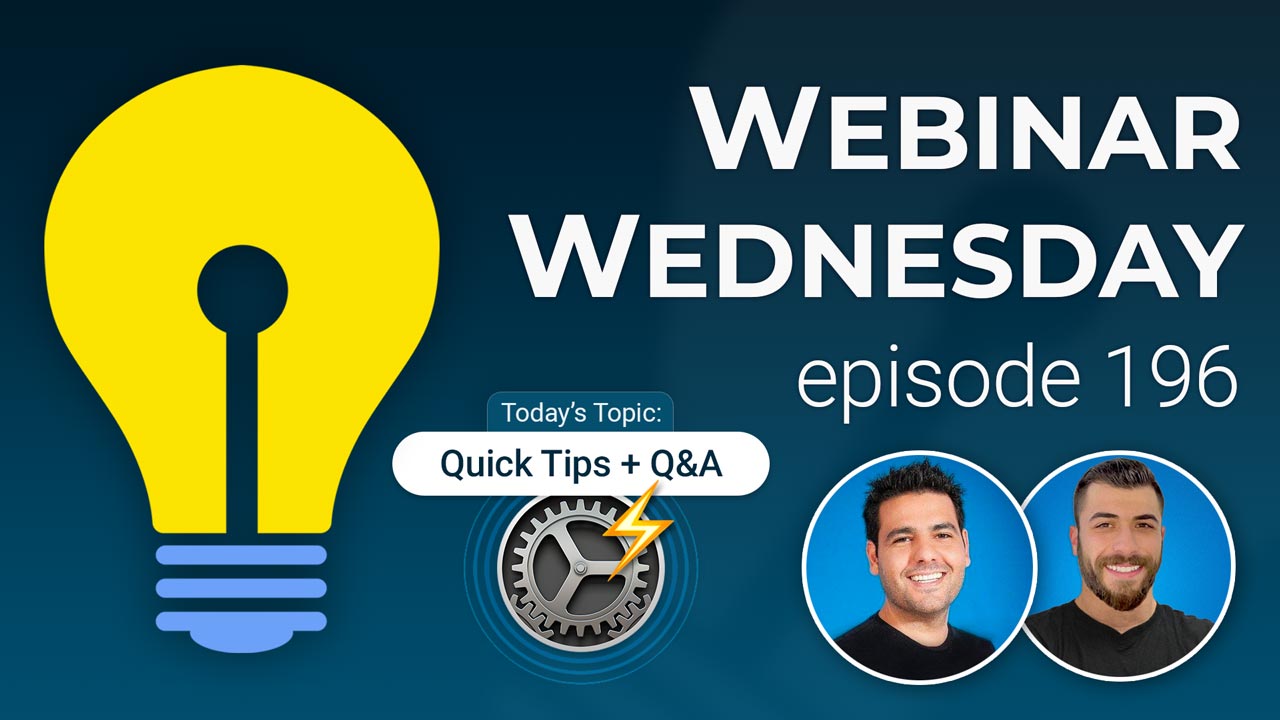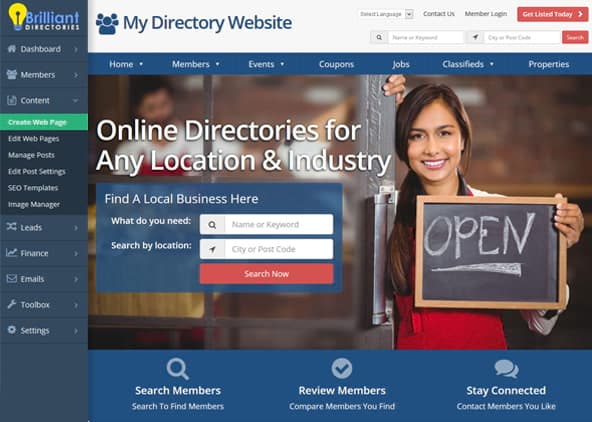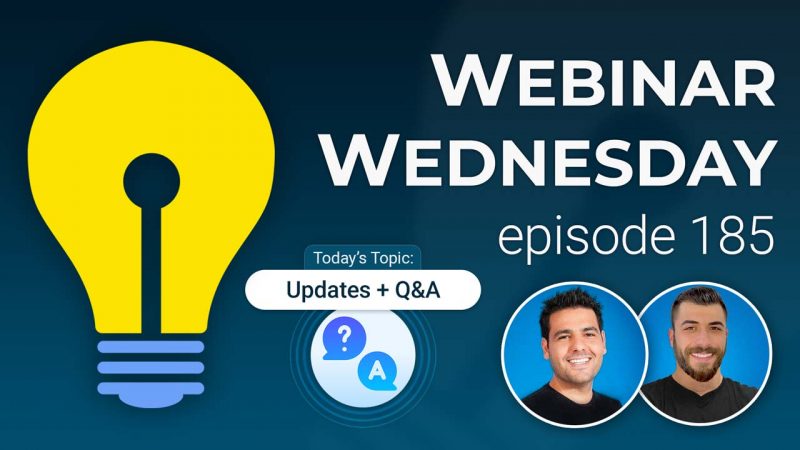
Key Topics:
- 02:09 – Brilliant Directories Mobile App
- 03:28 – LANGUAGES: Choose from 33 languages, covering 90% of cases
- New: Spanish (es-ES), Slovenian, Slovak, Albanian
- 05:06 – IMAGES: Keeps original if smaller than optimized version for faster site loading
- 05:53 – UI DESIGN: New -subtle class for alerts & badges—lighter, modern, theme-friendly
- 07:02 – EMOJIS: Use emojis without seeing ‘????’ after savings
- 08:31 – API SEARCH: Search members & posts via API, return JSON or HTML for 3rd-party sites
- 10:18 – EMAIL IMAGES: Fix for Outlook—ensures email images display at correct proportions
- 10:55 – DOMAINS: New wizard to update domains & revert to directoryup.com if needed
- 14:52 – BD Quick Tips
- 15:35 – 1) Require Complete Profiles – More Info
- 23:51 – 2) Available Billing Countries
- 28:41 – 3) Max. Sub-Categories Member Can Select – Industry Categories
- 38:50 – WordPress editing features for blog posts
- 42:40 – How to clone upload image field?
- 45:27 – Can we get a filter for published / non-expired events so we can quickly see what has already been posted?
- 48:33 – Is it possible to stream events, members, blogs, and top categories within the member dashboard?
- 53:52 – Is it possible to create a subdomain at scale and automated?
- 55:56 – So if you’re in Japan, they can simply change the language to Japanese?
- 57:42 – Can you make the search recognize the word “and” and/or the “&” as the same and thus search equally?
- 01:00:53 – What if the category doesn’t exist on the list, can I create it?
- 01:01:24 – What are the steps for restricting a member’s access to a custom members dashboard when their payment has failed and they are in past due status? Is there a method to limit their access without cancelling their membership plan or moving them to another plan?
- 01:03:46 – Ways to customize a member’s individual listing on the coding side. i.e. can you add a popup or change the css? – More Info
- 01:05:34 – What’s the best way to sell a product?
Announcements
New & Upcoming Features
Tip of the Week
Questions & Answers

 AI-Generated Transcript – Please excuse any inaccuracies
AI-Generated Transcript – Please excuse any inaccuracies
Brilliant Directories Mobile App (00:02:09)
- The Brilliant Directories Mobile App is a great way to stay updated with a Brilliant Directories site on the go, and can be found by searching for “Brilliant Directories” in the app stores or by following the URLs on the screen, such as brillianddirectories.com/slapple or the Google app (00:02:10).
- Webinar Wednesdays are a weekly event where new features, updates, and fixes to the Brilliant Directories platform are shared, and are often a result of feedback from the BD Community (00:02:32).
- The topics covered in Webinar Wednesdays include increasing traffic, converting visitors to members, revenue opportunities, and more, and attendees can ask questions on these topics by typing them into the comments or by having their microphone unmuted (00:02:59).
- The webinar format allows for interaction, including the ability to ask questions and have them answered, and attendees are encouraged to participate and ask for help if they are stuck on something (00:03:12).
- There are many updates to the Brilliant Directories platform, and these updates will be covered in the webinar, starting with the BD lab updates (00:03:19).
LANGUAGES: Choose from 33 languages, covering 90% of cases (00:03:28)
- The website setup process now allows users to choose from 33 languages, covering about 90% of cases, with the option to have approximately 95% of the front-end text in the selected language, such as Spanish language, when configuring the site (00:03:29).
- Recently added languages include Spanish specifically for Spain, Slovene language, Slavs, and Albanian language, which can be selected as the primary language for the site (00:03:53).
- The language selection can be made during the initial setup process using the setup wizard or later in the general settings under localization, where users can also choose to use the same language for text labels (00:04:04).
- The language change applies to almost all parts of the site, except for menus and a few other small areas, which can be changed separately, and users can test the language change by viewing the site’s text in the selected language, such as Japanese language (00:04:18).
- If a user needs a language that is not currently available, they can request it by emailing the support team, and the language will be added as requested (00:04:59).
- The website currently supports 33 languages, and users can switch between them in the general settings, allowing for more flexibility and customization options for users with different language preferences (00:04:57).
IMAGES: Keeps original if smaller than optimized version for faster site loading (00:05:06)
- When members upload images to posts, such as blog articles or profile photos, they may upload large file sizes, but the BD system optimizes them to a preferred size for the website (00:05:06).
- The BD system optimizes uploaded images to reduce their file size, but in rare cases, the optimized version may be larger than the original uploaded image (00:05:28).
- To address this issue, the system has been updated to keep the original image if it is smaller than the optimized version, which helps sites load faster over time (00:05:37).
- This update is a small detail, but it contributes to improving the overall loading speed of the website (00:05:49).
- The goal of this update is to ensure that sites load as quickly as possible, and every small improvement, such as keeping the original image if it is smaller, helps achieve this goal (00:05:51).
UI DESIGN: New -subtle class for alerts & badges-lighter, modern, theme-friendly (00:05:53)
- A new subtle class has been added for web designers to create a lighter, modern look for alerts, badges, and labels, which can be applied by adding a hyphen subtle to the element, such as alert success hyphen subtle or label success hyphen subtle (00:05:54).
- The subtle class provides a more subtle appearance compared to the regular alerts, badges, and labels, and can be used to add a modern touch to the design (00:05:58).
- The new subtle class will be applied to various elements in the main BD design framework, such as tags and alerts, to give them a more nuanced and modern look (00:06:51).
- The subtle class can be used for badges, alerts, and labels, and is intended to provide a more subtle and modern appearance, with examples including alert success hyphen subtle, label success hyphen subtle, and badge hyphen subtle (00:06:04).
- The addition of the subtle class is expected to enhance the overall design of landing pages and directories, and provide web designers with more flexibility and options for creating a modern and theme-friendly look (00:05:56).
EMOJIS: Use emojis without seeing ‘????’ after savings (00:07:02)
- Emoji can now be added anywhere when creating titles, which was a previously announced feature that is now available, allowing for more creative freedom in text editors and titles (00:07:03).
- The limitation of emojis not saving properly in the database has been resolved, eliminating the issue of seeing three or four question marks after saving changes, and emojis can now be used in the text editors in the admin (00:07:07).
- Emojis can be added to various elements, including titles, H1s, H2s, emails, meta titles, and meta descriptions, which can even be picked up by Google, and can also be added to URLs (00:07:38).
- The new feature allows for the use of emojis as attention grabbers, and users can experiment with different emojis to enhance their content, with the changes being saved and working as intended (00:07:45).
- The stability of emojis in different browsers is still to be determined, but the feature is currently working and available for use, allowing users to play with and utilize the various emojis (00:08:07).
- Users now have access to the emoji feature and can start using it to enhance their content, with the ability to add emojis to various elements and save the changes without any issues (00:08:22).
API SEARCH: Search members & posts via API, return JSON or HTML for 3rd-party sites (00:08:31)
- The Brilliant Director API now includes a search function for members and posts, allowing developers to perform searches using the API and receive results in either JSON or HTML format (00:08:31).
- This search function enables developers to search for members and posts on other websites, displaying the results on third-party websites, and is also useful for app development, particularly for creating native apps (00:08:37).
- The API return will be either JSON or HTML output, and this feature is primarily intended for developers, enabling them to tap into the API for various development purposes (00:08:52).
- The search function will work for both single image posts and multi-image posts, and documentation for the posts search will be added, in addition to the existing documentation for member searches (00:09:29).
- Developers using the API key can update post types, including blog articles, edit post types, manage the unsubscribed list, and update widgets remotely, allowing for higher-level development and updates on their Brilliant Directories website (00:09:57).
- The API endpoints, including the search for users (members), will be shared, and the documentation for posts will be updated to reflect the new search functionality (00:09:22).
EMAIL IMAGES: Fix for Outlook-ensures email images display at correct proportions (00:10:18)
- Microsoft Outlook is the most finicky email inbox for rendering images, being very sensitive to the proportions and ratios of the images, which has been a problem for newsletters looking good in Gmail but having issues in Outlook, such as stretched or out-of-proportion images (00:10:19).
- A recent update has been pushed to ensure email images display correctly, especially in Outlook, which should fix the issue of images being stretched or out of proportion in newsletters (00:10:26).
- If issues with image display in Outlook are still being experienced, they should be reported to the support team, who will troubleshoot them and potentially create a global fix for the entire community if an issue is identified (00:10:46).
- The goal is to create a global fix for any issues that are found, allowing the entire community to benefit from the solution, and this can be achieved by reporting any problems with image display in Outlook to the support team (00:10:50).
DOMAINS: New wizard to update domains & revert to directoryup.com if needed (00:10:55)
- A new domain change wizard has been introduced to connect custom domains to a Brilliant Directories website, and users can revert to a directoryup.com URL if needed, which is a useful feature for taking a site offline or getting it out of public view (00:10:56).
- The domain change wizard is a significant improvement over the previous method, which allowed users to save changes even if the domain was not properly connected, potentially breaking the site, and now it checks if the domain is valid before saving changes (00:11:12).
- When connecting a custom domain, users have two options: connect their own custom domain or revert to a directoryup.com URL, and the old domain will no longer be connected once a new one is set up (00:12:08).
- The domain change wizard provides instructions and videos to help users connect their domain, and it offers two methods: name server and A record, with the latter being replaced by CNAME record in the future (00:13:02).
- The wizard validates the domain name to ensure it is properly configured before saving changes, preventing users from saving a domain name that is not actually pointing to their Brilliant Directories website (00:13:53).
- The introduction of the domain change wizard is part of a series of updates, and the community is thanked for their feedback and suggestions, which are used to prioritize updates and fixes (00:14:29).
BD Quick Tips – Intro (00:14:52)
- A new segment was introduced in the last webinar, replacing the larger tip of the week presentation, to share a few quick tips on individual settings or features that might be overlooked in the platform (00:14:53).
- The quick tips cover various topics, including complete member profiles, available billing countries, and the maximum subcategories that members can select, with a focus on member profiles and finance (00:15:11).
- The segment includes three BD quick tips, with some tips related to member profiles and listings, and one tip related to the finance and billing side of things (00:15:14).
1) Require Complete Profiles (00:15:35)
- Requiring complete member profiles is a useful feature that ensures only complete profiles are displayed on the front end of a website, improving search quality and credibility by enhancing the user experience, and it can be enabled through a simple on/off toggle in the website’s general settings (00:15:35).
- When a new member registers on a website, especially if they are auto-approved, they may not complete their profile initially, and requiring complete profiles helps to prevent incomplete listings from being displayed in search results, which can take away from the overall user experience (00:16:05).
- The default fields required to be filled out for a member listing to display in search results include their name, category, profile photo or logo, and address, but these fields can be customized through an advanced setting called “complete profile field” (00:17:12).
- Requiring complete profiles can be particularly beneficial for directories of professional or businesses, as it encourages users to be more involved in the process and show that they care about their listing, which can help to maintain a professional and trustworthy directory (00:17:56).
- To enable the “require complete profiles” feature, users can go to their website’s general settings, search settings, and toggle the “required complete profiles” option to “yes”, which will prevent incomplete profiles from being displayed in search results (00:18:45).
- The number of members with incomplete profiles was reduced to 497, with approximately 3400 members not having the required fields completed, and there is a link to view settings where administrators can decide which fields are required (00:19:08).
- The support center has an article that explains how the required complete profile works, and it covers the system names that can be used in the comma-separated list of required fields (00:19:32).
- The complete profile fields can be customized by going to the advanced settings, where administrators can add or remove fields, such as company name, first name, and profession ID, and the changes can be saved (00:19:52).
- Removing the profile photo or file from the required fields list and saving the changes resulted in an increase in the number of members with complete profiles, from 497 to 848 (00:20:41).
- Administrators can add other fields to the required list by going to the form manager, customizing the listing contact details, and using the system names or database variable names (00:21:06).
- To make a field required, administrators can add the system name to the end of the comma-separated list, and the article shared in the comments provides more information on how to find the system names (00:21:41).
- It is essential to educate members on the importance of completing the required fields, and this can be done through a welcome email or a video, such as the one previously created on onboarding new members with a welcome plan (00:22:30).
- The welcome email can be used to greet new signups and provide them with information on how to get the most out of the site, including completing their profiles (00:22:55).
- The welcome email sent to new members after they register with their email address is crucial as it serves as the first greeting and an opportunity to educate them on how to get the most out of the website, including the next steps and actions to take (00:22:59).
- The email should provide clear instructions and direction on how to utilize the site, especially if it’s a classified website, where new members are encouraged to post their first classified (00:23:25).
- Giving new members easy wins by providing clear instructions on what to do next with their profiles is a great tip, and there is a video that covers this topic well, which will be shared in the comments (00:23:36).
- The setup process after the initial registration is important, and the welcome email plays a key role in guiding new members through this process and helping them get the most from the site (00:23:04).
2) Available Billing Countries (00:23:51)
- The available billing countries feature allows users to choose which countries will appear in the drop-down list as billing options when a prospective member is on one of their checkout pages, entering their credit card information to pay for a membership plan (00:23:51).
- This feature enables users to restrict payments to specific countries and prioritize frequently used countries at checkout, making them more easily accessible to users and allowing them to tailor their checkout pages to their specific target markets (00:23:54).
- It is essential to consider that excluding certain countries from the billing options might prevent potential members from registering, especially if they live in a neighboring country, and this feature can be used to focus on individual target countries (00:24:40).
- To access this feature, users can go to their Finance settings, payment gateways, and then the additional settings dropdown, where they can find the billing address countries and set individual countries to active, not active, or featured (00:25:37).
- The featured countries will appear at the top of the drop-down list, and users can prioritize their primary country by setting it to featured, making it more easily accessible to their target audience (00:25:44).
- The default countries that appear at the top of the list are the United States, Canada, Australia, New Zealand, and the United Kingdom, but users can customize this list to suit their business needs (00:26:21).
- Users can add new countries to the list, set them to active or featured, and save the changes to update the billing options on their checkout page (00:26:54).
- The countries can be listed in alphabetical order, and users can remove or add the featured status to countries as needed to prioritize their primary country (00:27:16).
- This feature provides a great way to prioritize a user’s country at the top of the billing information, making it more convenient for their target audience to register for a membership plan (00:28:07).
3) Max. Sub-Categories Member Can Select (00:28:41)
- Members can be limited to a specific number of subcategories they can select, which can be used as a monetization option by creating tiered membership plans with different category limits (00:28:49).
- This feature can encourage members to focus on their specific niches and specialties, rather than trying to be listed in every subcategory, by limiting them to a specific number of subcategories (00:29:04).
- The maximum sublevel categories members can select option can be set on a per membership plan basis, and can be edited in the finance and membership plans section, with options to enter a specific number, zero, the word “all”, or “unlimited” (00:30:31).
- Setting a limit on the number of subcategories members can select can prevent category overuse and make listings more relevant, which can be beneficial for websites where members may try to be listed in every subcategory (00:30:01).
- The feature can be used to create an incentive for members to upgrade to more premium plans, which can offer more subcategory options, such as being listed in up to 10 subcategories or an unlimited number of subcategories (00:29:16).
- A subcategory is a more specific category within a larger category, and can be used to help members narrow down their specialties and niches, with examples of subcategories available in the resources tab on the Brilliant Directory site (00:31:34).
- The top-level category is selected by a business when they join a site, and then they can choose their sub and sub-sub categories, such as automotive services, auto repair, auto detailing, auto glass, and auto parts (00:32:16).
- To prevent members from selecting every category for self-serving purposes, it is recommended that they choose categories that align with their services, and this can be controlled by limiting the number of sublevel categories they can select, such as five for a free plan or 20 for a higher-tiered plan (00:32:38).
- A category takeover can be offered as a membership plan, where a member can be listed in all subcategories for a fee, such as $50 a month, and this setting can be found in the admin area under the membership plan settings (00:33:12).
- In the membership plan settings, there is an option to set the maximum number of subcategories a member can select, and if the option is set to “all”, the member will automatically be listed in all subcategories as soon as they select their top-level category (00:34:21).
- The “all” option is different from the “unlimited” option, as the “all” option automatically assigns the member to every sublevel category, while the “unlimited” option sets no cap on the number of categories the member can choose (00:35:41).
- The category takeover feature can be monetized by offering different tiers of membership plans, such as a lower-tiered plan that allows members to be listed in up to five categories, and a higher-tiered plan that allows members to be listed in up to 20 categories (00:35:29).
- Categories for membership listings can be unrestricted, allowing users to choose as many subcategories as they want, with options including unlimited, all, or a specific number, and this feature is particularly useful for business directories, especially those that are industry-focused, such as an attorney directory with subcategories for different specializations of law (00:36:00).
- The categorization process can be separated into two steps, with users first choosing their top-level category and then their sublevel category, but there is also an option to put these categories on one form to create a seamless workflow, as described in an article on how to place top and sublevel categories on one form (00:37:17).
- When signing up as a member, users can select their top-level category in the first tab, which includes fields for their name, company, phone number, and a “best describes you” field, and then choose their sublevel category in the additional details tab, but an article is available that explains how to stack these categories on top of each other for a more streamlined process (00:37:24).
- The user flow can be improved by putting the top category and subcategory selection in one place, making it easier for users to select their categories, and for those who are more tech-savvy, there is a support document available that provides more information on how to do this, including an article on selecting categories as a member (00:38:02).
- After discussing the categorization process, there is time for a Q&A session, where users can type in their questions or request to have their microphone unmuted to ask questions verbally, and they can also type in comments on Facebook, YouTube, or the stream page (00:38:20).
WordPress editing features for blog posts (00:38:50)
- The WordPress editing features for blog posts include pre-made blocks that can be added to a blog post, and users can drag and drop these blocks, change the default text and images, and move them around as needed (00:38:55).
- The content block tables can be edited and moved around, and users can also access a code view to dive into the HTML if they are familiar with it (00:40:01).
- A full screen mode or a taller window is currently missing in the frontend text editors, but once this feature is added, it should be a good precedent for editing features (00:40:15).
- The pre-made blocks can be enabled for different post types, such as blog posts or classifieds, and users can choose to give their members access to these blocks when creating their posts (00:41:47).
- There are several form field types that can be used to add pre-made elements to a blog post, including the image upload with pre-made elements, and the basic text editor (00:41:25).
- The media manager one should not be assigned to post types or forms used for post types that are admin only, as it gives access to the site’s media manager and images (00:42:26).
- The pre-made elements can be enabled safely for all different post types, and users can choose to give their members access to these elements when creating their posts (00:42:07).
How to clone upload image field? (00:42:40)
- When creating a form with an image upload field, cloning the field may only result in one image upload field being available, likely due to the use of the add-on for file uploads for forms, which allows users to upload various media such as images, PDF files, and more (00:42:42).
- To troubleshoot the issue, it is recommended to ensure that the database variable name is different for each cloned field, and that each field has its own unique database variable, as every field needs to have its own unique identifier (00:43:45).
- If the issue persists, it is suggested to raise a support ticket to allow the support team to recreate the issue and provide further troubleshooting, and it is also recommended to check the support document for the add-on, which mentions the requirement for a unique outer element ID for each file upload field (00:44:13).
- Each individual file upload field needs its own additional field CSS class in the outer element ID, and the outer element ID needs to be unique for each upload field, which can be achieved by giving each field a unique class, such as “test one” and “test two” (00:44:27).
- To resolve the issue, it is advised to make sure that the outer element ID has a unique value for each cloned field, as cloning the field may result in the same outer element ID being used, and if the issue is still not resolved, it is recommended to reach out to the support team for further guidance (00:45:10).
Can we get a filter for published / non-expired events so we can quickly see what has already been posted? (00:45:27)
- Hans is congratulated on starting his second BD site and requests the addition of a payment gateway for Indonesia, such as Zenit, which would be a great and useful edition (00:45:35).
- The process of adding payment gateways is a bit tricky, but efforts are being made to work on a newer system to make it more seamless, and Hans is asked to provide more information on other payment gateways that are not supported in Indonesia (00:45:46).
- Tony suggests having a filter for published, non-expired events to quickly see what has already been posted and to prevent expired events from burying still active or future events (00:46:27).
- There is a setting that allows for filtering of non-expired events, but the exact location of this setting is unclear, and Tony is asked to email the support team to get more information on how to access this feature (00:48:11).
- The setting in question would allow users to only display non-expired events, such as upcoming events or events that are currently happening, and disregard all past or expired events (00:46:58).
- A search for events in the future will not show already finished or expired events, but the exact setting to never show expired events in search results is not immediately found (00:47:35).
Is it possible to stream events, members, blogs, and top categories within the member dashboard? (00:48:33)
- It is possible to stream events, members, blogs, and top categories within the member dashboard, and this feature can help boost engagement, but the dashboard might get cluttered (00:48:34).
- To achieve this, widgets can be used, and the process involves copying and pasting the widget name into the membership plan’s custom dashboard content, which can be done by editing the membership plan and using the text editor (00:49:01).
- The same process can be applied to stream events, and the widget name can be obtained by going to the homepage, hitting the show widgets button, and copying the name of the events widget (00:49:25).
- An alternative option is to create a separate main menu for members, which can include a link to a members-only web page that streams the content, and this can be done by utilizing the recently released feature of having a different main menu for logged-in members (00:51:30).
- This approach allows for a cleaner dashboard and provides more flexibility in terms of customizing the user experience, and a video is available that provides more information on how to enhance the user experience with a custom main menu (00:52:15).
- A custom main menu can be created for registered members, allowing them to access members-only pages with streaming content or direct links to publish posts when they are logged in, whereas the public sees a “join our site now” message when not logged in (00:52:27).
- To address a question, a streaming section was added by copying and pasting the widget name to the dashboard, which was a relatively easy process (00:52:50).
- Lisa addressed Tony’s previous question about not showing expired events in search results, explaining that there is an additional setting to control this, found by editing the event post type, going to search results design, and then to the additional settings where the option to display expired posts in search results can be toggled (00:53:00).
- The setting to display expired posts in search results is located at the very bottom of the additional settings in the search results design section, and setting it to “no” instead of “yes” should help achieve the desired outcome of not showing expired events (00:53:32).
- The platform’s numerous settings can be both a gift and a curse, making it sometimes necessary to search thoroughly to find the correct setting, as was the case with the display expired posts option (00:53:25).
Is it possible to create a subdomain at scale and automated? (00:53:52)
- Creating subdomains at scale and automated is possible, but as of now, there isn’t an API or automated way to do it remotely, and users need to log in to their CPanel dashboard in the Developer Hub to create a subdomain (00:53:52).
- To create a subdomain, users can search for “domains” in the cPanel dashboard and look for the area to create an A record, Zone editor, or something similar, as this is a common process in cPanel (00:54:29).
- In the cPanel dashboard, users can add an A record, CNAME record, MX, and create subdomains, and while it may not be possible to do it remotely on a large scale, it only takes a second to set up once logged in (00:54:56).
- Users who need to create multiple subdomains can do so in the cPanel, and it is recommended to Google “C panel add a create a subdomain” or check the documentation for more information (00:55:21).
- There is an article in the support center on creating a subdomain, although it may not be immediately found, and users can search for it in the support center for more information (00:55:37).
So if you’re in Japan, they can simply change the language to Japanese? (00:55:56)
- If a site is set up for the Japanese language market, the language can be changed to Japanese, but there are two different language settings to consider, the site’s starting language and the option for users to translate the site on the fly (00:55:57).
- The site’s starting language, set in the general settings, determines the main language of the site and is the language that members will likely use when creating posts and entering information about their business (00:56:56).
- For sites with an international market, the Google translate add-on can be used to allow visitors from different countries to translate the site into their own language, with the translation being done dynamically based on the selected language (00:56:26).
- The Google translate tool provides a drop-down menu at the top of the screen, allowing users to choose their preferred language, and it does a reasonably good job of translating the site, around 80% accurate, which is sufficient to allow visitors to understand the site’s content (00:57:21).
- The Google translate toggle is a useful option for sites with a large international audience, as it enables visitors to read the site in their own language, even if the site’s main language is set to Japanese or another language (00:57:19).
Can you make the search recognize the word “and” and/or the “&” as the same and thus search equally? (00:57:42)
- The system does not perform fuzzy searches, which are complicated and typically found in applications like Yelp, where the system attempts to figure out what the user is trying to type and provides the best possible answer (00:58:13).
- To make the search recognize the word “and” and/or the “&” as the same, a customization might be required, especially for category searches, but there is an option to add related keywords for categories (00:58:00).
- Related keywords can be used to include variations of the category name, such as “chiropractor and back pain” or “chiropractor & back pain”, which can be added as a comma-separated list to match the main category (00:58:50).
- The related keywords feature allows the system to suggest the category even if the user types a variation of the category name, and an add-on called “keywords for categories” can be used to add alternate variations of the category name (01:00:46).
- This add-on is helpful for including different terms that users might type, such as “kirro”, “chiropractor”, “doctor”, or “physician”, without having to create separate categories for each term (01:00:32).
- By using the related keywords feature and the “keywords for categories” add-on, users can search for categories using different terms and still find the relevant results (01:00:50).
What if the category doesn’t exist on the list, can I create it? (01:00:53)
- If a category does not exist on the list, it is possible to create it, and this is in reference to member categories, which can be edited, modified, added, or removed (01:00:53).
- The pre-made categories provided are just starting points and are based on generalizations for different industries, allowing users to make changes as needed (01:00:56).
- Users are encouraged to change and customize the categories to fit their specific needs, as the initial categories are broad generalizations of popular categories in certain industries (01:01:00).
What are the steps for restricting a member’s access to a custom members dashboard when their payment has failed and they are in past due status? Is there a method to limit their access without cancelling their membership plan or moving them to another plan? (01:01:24)
- To restrict a member’s access to a custom member’s dashboard when their payment has failed and they are in past due status, the system automatically limits their access to members-only pages, likes, and bookmarks because they are not an active member (01:01:24).
- When a member is not in active status, such as being past due, on hold, or cancelled, they cannot view members-only pages or interact with certain site features, and this restriction applies to anything beyond being fully deleted from the site (01:01:41).
- The member dashboard may contain custom content and members-only information, and to check if a member is active, a status check can be performed where status equals 2 indicates an active member (01:02:26).
- To limit access to sensitive members-only content in the dashboard, a code-based solution can be implemented, such as wrapping the content in a conditional check for active membership status, which can be found in the marketplace for additional guidance (01:03:00).
- If members-only content is sensitive, it is recommended to wrap it in a conditional check to ensure only active members can access it, and help with implementing this solution can be found in the marketplace (01:03:31).
Ways to customize a member’s individual listing on the coding side. i.e. can you add a popup or change the css? (01:03:46)
- Customizing a member’s individual listing on the coding side is possible, and examples of customization include adding a popup or changing the CSS, with a video available that covers beginner settings to advanced coding settings, including CSS and popups (01:03:46).
- The video showcases the transformation of a member profile page, starting with a standard “LinkedIn style” profile and ending with a customized version that includes a cover photo, a circular design and border around the image, and a white gradient with opacity (01:04:23).
- The customized profile page is an example of what can be achieved with basic level design and development skills, and it is possible to add CSS, popups, and extra JavaScript to member profile pages (01:05:15).
- A video resource is available that demonstrates the possibilities of customizing member profile pages, and it is recommended for designers and developers who want to learn more about customizing member listings (01:05:30).
What’s the best way to sell a product? (01:05:34)
- To sell a product, it is recommended to use the sell digital products and services add-on, which allows for the creation of checkout links for various products and services, including one-off products, subscriptions, donations, and custom amounts (01:05:55).
- The digital products feature has been revamped and now includes more options, such as selling subscriptions and taking donations, making it a robust tool for monetizing a site (01:06:01).
- The sell digital products and services add-on enables users to monetize their site in multiple ways, beyond just membership plans, and can be used to sell services like SEO, ebooks, and banner ads (01:06:50).
- A video is available that provides more information on how to use the digital products feature, and a link to this video will be shared in the comments (01:06:12).
- The Brilliant Directories platform has undergone significant updates, including new settings and features, and the community is encouraged to provide feedback and suggestions to make the platform better (01:07:31).
- The webinar will be posted in the Facebook group, and a replay will be available for those who missed it, and there will be an IPad giveaway in the Facebook group at the end of the month (01:07:47).
- The next webinar will be held in two weeks, and users are encouraged to join the Facebook group and download the Brilliant Directories app (01:07:42).














